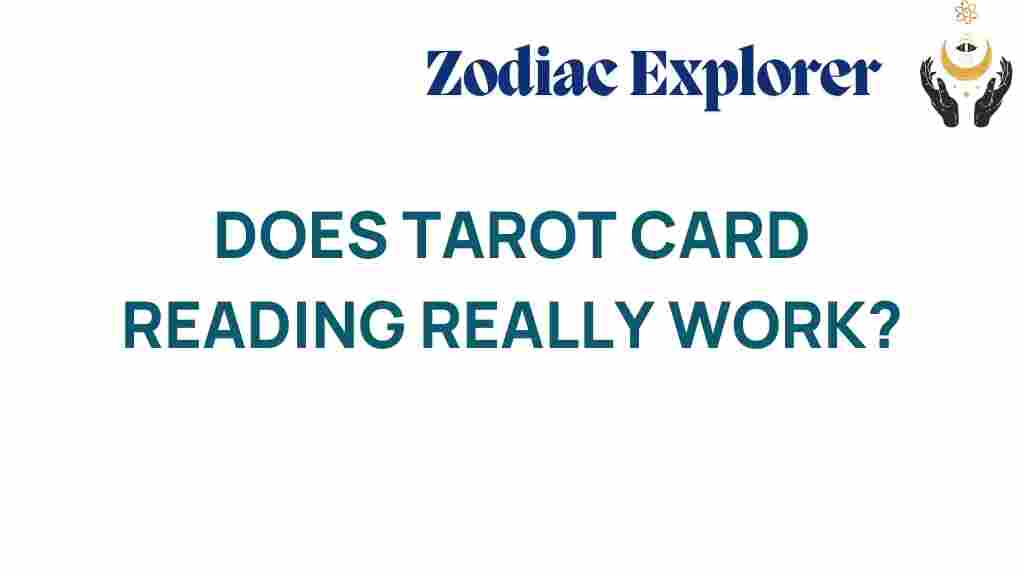Unveiling the Truth: Does Tarot Card Reading Really Work?
Tarot card reading has long been a subject of fascination, intrigue, and skepticism. This ancient form of divination is often viewed as a tool for fortune-telling, self-discovery, and spiritual insight. But does it really work? In this article, we will delve into the world of tarot, exploring its psychological, spiritual, and symbolic dimensions to uncover the truth behind this captivating practice.
Understanding Tarot Card Reading
Before we can evaluate its effectiveness, it’s essential to understand what tarot card reading entails. At its core, tarot involves the use of a deck of 78 cards that are rich in symbolism and archetypes. Each card represents different aspects of life, emotions, and experiences, allowing the reader to interpret their meanings based on the context of the question posed.
- The Major Arcana: These 22 cards represent significant life events or spiritual lessons.
- The Minor Arcana: Comprising 56 cards, these cards delve into everyday situations and challenges.
Many people believe that tarot card reading serves as a mirror for the soul, reflecting the reader’s intuition and insights about a person’s life or situation.
The Role of Intuition and Spirituality
Intuition plays a vital role in tarot card reading. Readers often rely on their gut feelings and spiritual connections to interpret the cards. This aspect ties closely to spirituality, as many practitioners view tarot as a means of connecting with higher realms or universal truths.
- Intuition: The ability to understand something instinctively without the need for conscious reasoning.
- Spirituality: A broad concept that often involves a sense of connection to something greater than oneself.
Through tarot, individuals can explore their inner thoughts and feelings, enhancing their self-discovery journey. This process allows for increased self-awareness and personal growth, as practitioners reflect on their life choices and beliefs.
Psychology and the Power of Suggestion
From a psychological perspective, tarot card reading can be seen as a powerful tool for self-exploration. The act of drawing cards can prompt individuals to consider their current circumstances and emotions, leading to valuable insights. This is particularly relevant in therapeutic settings, where tarot may serve as a catalyst for discussion and reflection.
Moreover, the placebo effect also plays a significant role in the perception of tarot’s effectiveness. When individuals believe in the power of tarot, they may experience positive outcomes simply through the act of engaging with the cards.
Symbolism in Tarot
Every card in the tarot deck is steeped in symbolism. Understanding these symbols can deepen the reading experience, as they often represent universal truths and collective experiences. Here are a few key symbols found in tarot:
- The Fool: New beginnings and spontaneity.
- The Tower: Sudden upheaval and revelation.
- The Lovers: Relationships and choices.
By examining these symbols, readers can gain insights into their own beliefs and perceptions, fostering a deeper understanding of their life situations.
Step-by-Step Process of Tarot Card Reading
If you’re interested in trying tarot card reading, here’s a simple step-by-step guide to get you started:
- Choose Your Deck: Select a tarot deck that resonates with you. Popular options include the Rider-Waite and Thoth decks.
- Set the Intention: Before you begin, take a moment to focus on the question or issue you wish to explore.
- Shuffle the Cards: As you shuffle, concentrate on your intention, allowing your energy to connect with the cards.
- Draw the Cards: Depending on your preferred spread (the layout of cards), draw the necessary number of cards.
- Interpret the Cards: Use your knowledge of the card meanings, along with your intuition, to interpret the reading.
- Reflect: Take time to reflect on the reading and how it relates to your life.
Common Misconceptions About Tarot
Despite its growing popularity, many misconceptions about tarot card reading persist. Let’s explore a few of these:
- Tarot is Only for Fortune-Telling: While many associate tarot with predicting the future, it is more about self-discovery and personal insight.
- You Must Be Psychic: Although some readers may possess psychic abilities, intuition is something everyone can develop.
- Tarot is Unreliable: The effectiveness of tarot often depends on the individual’s openness and belief system.
Troubleshooting Tips for Tarot Reading
As you embark on your journey with tarot card reading, you may encounter challenges or doubts. Here are some troubleshooting tips:
- Feeling Overwhelmed: If you find the cards confusing, start with just a few cards until you feel more comfortable.
- Interpreting Messages: Don’t be afraid to trust your intuition. The cards can have personal meanings unique to your experiences.
- Maintaining Focus: If you struggle to concentrate, consider meditative practices to clear your mind before reading.
Conclusion: The Truth About Tarot Card Reading
In conclusion, tarot card reading serves as a powerful tool for self-discovery, spiritual exploration, and psychological insight. While it may not provide definitive answers or predictions, it encourages individuals to reflect on their lives, beliefs, and emotions. Whether you view tarot as a form of divination, a psychological tool, or a spiritual practice, its effectiveness largely depends on your openness and willingness to engage with its symbolism.
Ultimately, the truth about tarot lies not in its ability to predict the future but in its capacity to guide us toward a deeper understanding of ourselves and our journeys. Whether you’re a skeptic or a believer, exploring tarot card reading can lead to valuable insights and growth.
For more information on exploring spirituality and self-discovery, check out this resource. If you’re interested in learning more about the psychological aspects of tarot, consider visiting this article.
This article is in the category Myths and created by ZodiacExplorer Team
